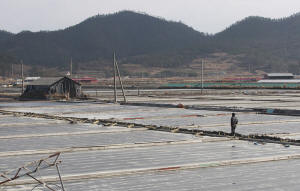US blocks sea salt imports from South Korean salt farm over forced labor
concerns
[April 07, 2025] By
KIM TONG-HYUNG
SEOUL. South Korea (AP) — The United States has blocked imports of sea
salt products from a major South Korean salt farm accused of using slave
labor, becoming the first trade partner to take punitive action against
a decadeslong problem on salt farms in remote islands off South Korea’s
southwest coast.
U.S. Customs and Border Protection issued a withhold release order
against the Taepyung salt farm, saying information “reasonably
indicates” the use of forced labor at the company in the island county
of Sinan, where most of South Korea’s sea salt products are made.
Under the order issued last Wednesday, Customs personnel at all U.S.
ports of entry are required to hold sea salt products sourced from the
farm.
Taepyung is South Korea's largest salt farm, producing about 16,000 tons
of salt annually, which accounts for approximately 6% of the country’s
total output, according to government data, and is a major supplier to
South Korean food companies. The farm, located on Jeungdo island in
Sinan and leasing most of its salt fields to tenants, has been
repeatedly accused of using forced labor, including in 2014 and 2021.
South Korean officials stated that this was the first time a foreign
government had suspended imports from a South Korean company due to
concerns over forced labor.

In a statement to The Associated Press on Monday, South Korea’s Foreign
Ministry said relevant government agencies, including the Ministry of
Oceans and Fisheries, have been taking steps to address labor practices
at Taepyung since 2021. While not providing direct evidence, it said it
assesses that none of the salt produced there now is sourced from forced
labor. The ministry said it plans to “actively engage” in discussions
with the U.S. officials over the matter.
The fisheries ministry said it plans to promptly review the necessary
measures to seek the lifting of the U.S. order.
The widespread slavery at Sinan’s salt farms was exposed in 2014 when
dozens of slavery victims — most of them with disabilities — were
rescued from the islands following an investigation by mainland police.
Some of their stories were documented by The Associated Press, which
highlighted how slavery persisted despite the exposure.
U.S. Customs said it identified several signs of forced labor during its
investigation of Taepyung, including “abuse of vulnerability, deception,
restriction of movement, retention of identity documents, abusive living
and working conditions, intimidation and threats, physical violence,
debt bondage, withholding of wages, and excessive overtime.”
Lawyer Choi Jung Kyu, part of a group of attorneys and activists who
petitioned U.S. Customs to take action against Taepyung and other South
Korean salt farms in 2022, expressed hope that the U.S. ban would
increase pressure on South Korea to take more effective steps to
eliminate the slavery.
[to top of second column] |

A salt farm owner walks around his salt farm on Sinui Island, South
Korea, Feb. 19, 2014. (AP Photo/Ahn Young-joon, File)
 “Since the exposure of the problem
in 2014, the courts have recognized the legal responsibility of the
national government and local governments, but forced labor among
salt farm workers has not been eradicated,” Choi said. “Our hope is
that the export ban would force companies to strengthen due
diligence over supply chains and lead to the elimination of human
rights violations.”
Choi’s law firm and other groups representing salt farm slavery
victims issued a statement urging the South Korean government to
take stronger action to prevent the ongoing abuse, including harsher
punishments for trafficking and forced labor crimes. They also
criticized the lack of support measures for victims, such as
employment and housing assistance, which has led some to return to
salt farms.
Most of the salt farm slaves rescued in 2014 had been lured to the
islands to work by brokers hired by salt farm owners, who would beat
them into long hours of hard labor and confine them at their houses
for years while providing little or no pay.
The slavery was revealed in early 2014 when two police officers from
the capital, Seoul, disguised themselves as tourists to
clandestinely rescue a victim who had been reported by his family as
missing. One of the Seoul police officers told AP they went
undercover because of concerns about collaboration between the
island’s police and salt farm owners. Dozens of farm owners and job
brokers were indicted, but no police or officials were punished
despite allegations some knew about the slavery.
In 2019, South Korea’s Supreme Court upheld a lower court ruling
that ordered the government to compensate three men who had been
enslaved on salt farms in Sinan and the neighboring county of Wando,
acknowledging that local officials and police failed to properly
monitor their living and working conditions.
The salt farm slavery issue resurfaced in 2021 when around a dozen
workers at Taepyung were discovered to have endured various labor
abuses, including forced labor and wage theft.
All contents © copyright 2025 Associated Press. All rights reserved
 |